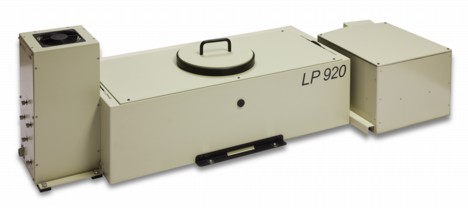Home > Press > Edinburgh Instruments’ Spectrometer Helps Identify New Electronic State In Carbon Nanotube Research
 |
Abstract:
Researchers at Duke University1 have utilised the LP920 laser flash photolysis spectrometer from Edinburgh Instruments to experimentally observe excited triplet states of individualised single-wall carbon nanotubes (SWNTs) for the first time. These SWNT triplet excitons have lifetimes of the order of microseconds, differing vastly the picosecond lifetimes characteristic of the well-known SWNT singlet excitons. This research provides new insights into the fundamental photophysical processes of 1-dimensional carbon-based nanostructures.
Edinburgh Instruments’ Spectrometer Helps Identify New Electronic State In Carbon Nanotube Research
Livingston, UK | Posted on March 8th, 2012SWNTs facilitate ballistic charge transport and fast singlet exciton migration over long distances; such properties are highly useful for electronic and photonic devices. The experimental identification of the SWNT triplet exciton state expands significantly the scope of nanotube electron and energy migration reactions that can be exploited.
Nanosecond pump-probe transient absorption spectroscopic experiments of purified, polymer wrapped SWNTs in a variety of solvents was carried out using the LP920 laser flash photolysis spectrometer equipped with the L900 software for control and data acquisition. A previously unidentified transient absorption band at 1150 nm is shown to correspond to a SWNT T1 to Tn transition; the lifetime of the SWNT triplet excited state was found to be 17.4 and 6.5 µs, respectively, in D2O and DMSO solvents.
In this study, (6,5)-chirality enriched semiconducting SWNTs that were helically wrapped by an aryleneethynylene polymer monolayer at periodic and constant morphology, were utilised. These polymer-wrapped SWNTs maintain uniform structural morphology in both D2O and DMSO solvents, and provide versatile constructs in which to probe nanotube triplet exciton states.
The LP920 laser flash photolysis spectrometer is a fully automated turnkey solution for the reliable and accurate measurement of transient absorption either in spectral and/or kinetic mode. It has a large sample chamber to house a variety of sample holders.
####
For more information, please click here
Contacts:
Press Enquiries:
In Press Public Relations Ltd
PO Box 24
Royston, Herts, SG8 6TT
Tel: +44 1763 262621
Internet: www.inpress.co.uk
Other Enquiries:
Edinburgh Instruments
Photonics Division
2 Bain Square, Kirkton Campus
Livingston, EH54 7DQ, UK
Tel: + 44 1506 425 300
Internet: www.edinburghphotonics.com
Copyright © Edinburgh Instruments Ltd.
If you have a comment, please Contact us.Issuers of news releases, not 7th Wave, Inc. or Nanotechnology Now, are solely responsible for the accuracy of the content.
| Related News Press |
News and information
![]() Simulating magnetization in a Heisenberg quantum spin chain April 5th, 2024
Simulating magnetization in a Heisenberg quantum spin chain April 5th, 2024
![]() NRL charters Navy’s quantum inertial navigation path to reduce drift April 5th, 2024
NRL charters Navy’s quantum inertial navigation path to reduce drift April 5th, 2024
![]() Discovery points path to flash-like memory for storing qubits: Rice find could hasten development of nonvolatile quantum memory April 5th, 2024
Discovery points path to flash-like memory for storing qubits: Rice find could hasten development of nonvolatile quantum memory April 5th, 2024
Nanotubes/Buckyballs/Fullerenes/Nanorods/Nanostrings
![]() Tests find no free-standing nanotubes released from tire tread wear September 8th, 2023
Tests find no free-standing nanotubes released from tire tread wear September 8th, 2023
![]() Detection of bacteria and viruses with fluorescent nanotubes July 21st, 2023
Detection of bacteria and viruses with fluorescent nanotubes July 21st, 2023
Announcements
![]() NRL charters Navy’s quantum inertial navigation path to reduce drift April 5th, 2024
NRL charters Navy’s quantum inertial navigation path to reduce drift April 5th, 2024
![]() Discovery points path to flash-like memory for storing qubits: Rice find could hasten development of nonvolatile quantum memory April 5th, 2024
Discovery points path to flash-like memory for storing qubits: Rice find could hasten development of nonvolatile quantum memory April 5th, 2024
Tools
![]() Ferroelectrically modulate the Fermi level of graphene oxide to enhance SERS response November 3rd, 2023
Ferroelectrically modulate the Fermi level of graphene oxide to enhance SERS response November 3rd, 2023
![]() The USTC realizes In situ electron paramagnetic resonance spectroscopy using single nanodiamond sensors November 3rd, 2023
The USTC realizes In situ electron paramagnetic resonance spectroscopy using single nanodiamond sensors November 3rd, 2023
|
|
||
|
|
||
| The latest news from around the world, FREE | ||
|
|
||
|
|
||
| Premium Products | ||
|
|
||
|
Only the news you want to read!
Learn More |
||
|
|
||
|
Full-service, expert consulting
Learn More |
||
|
|
||








